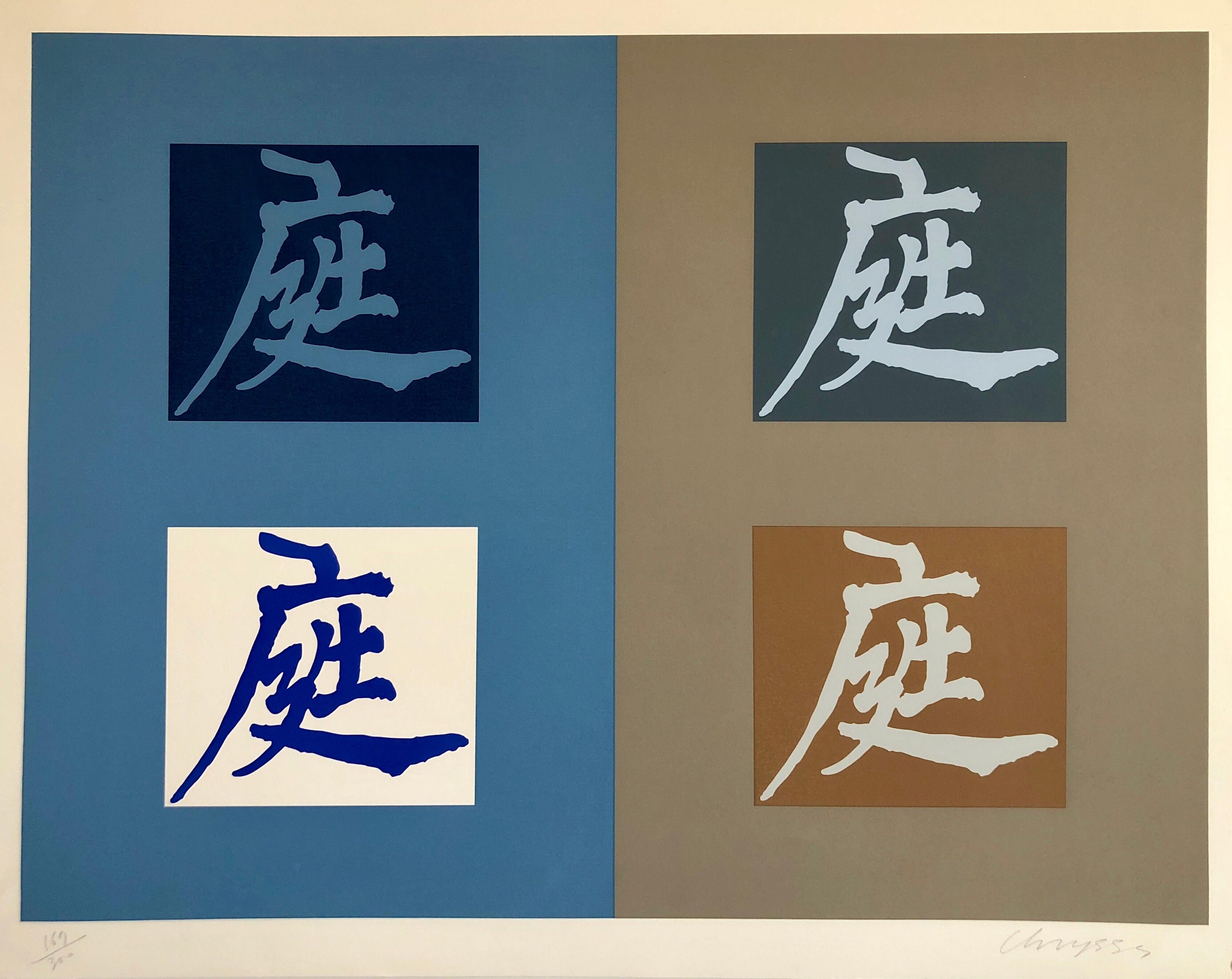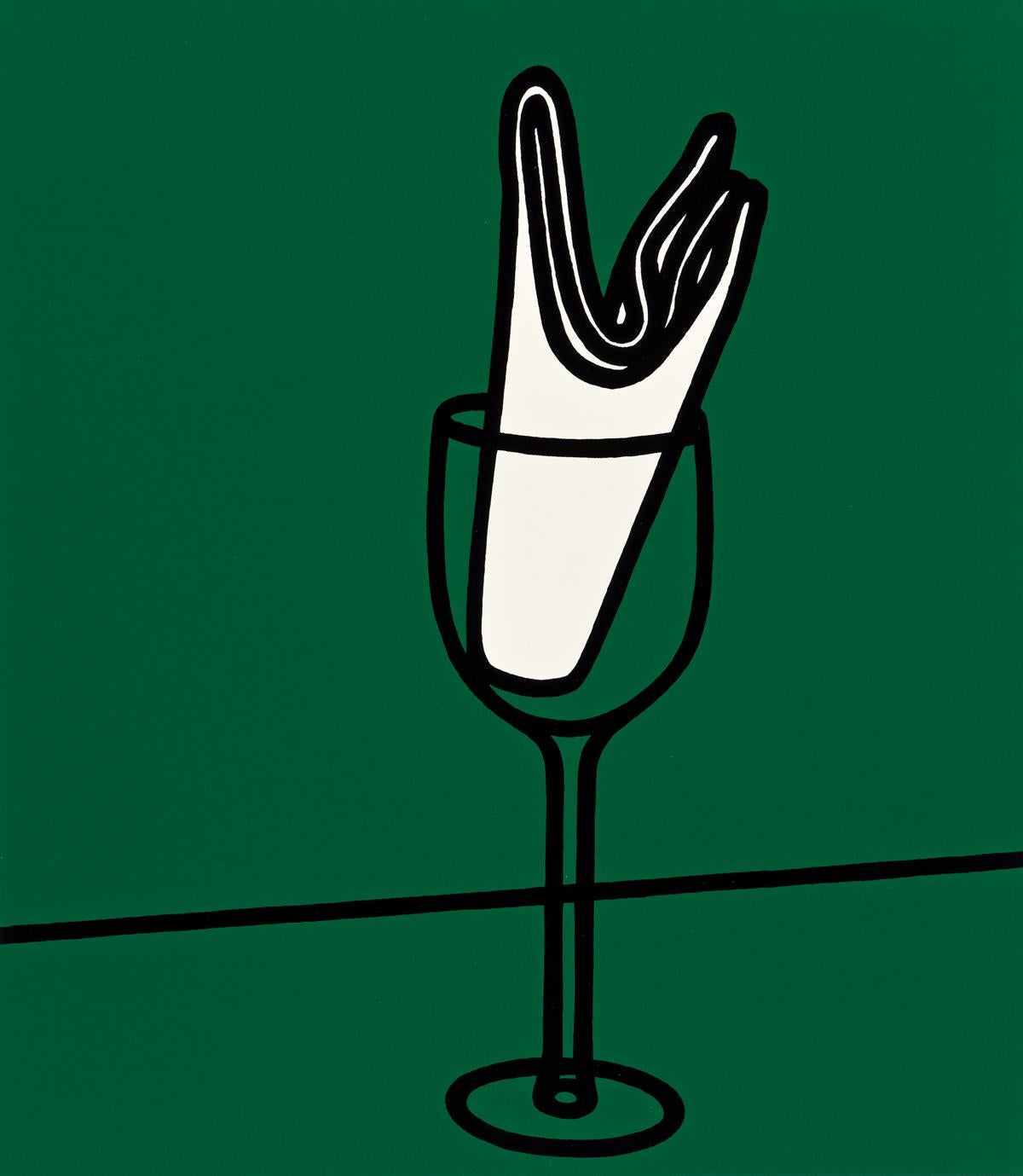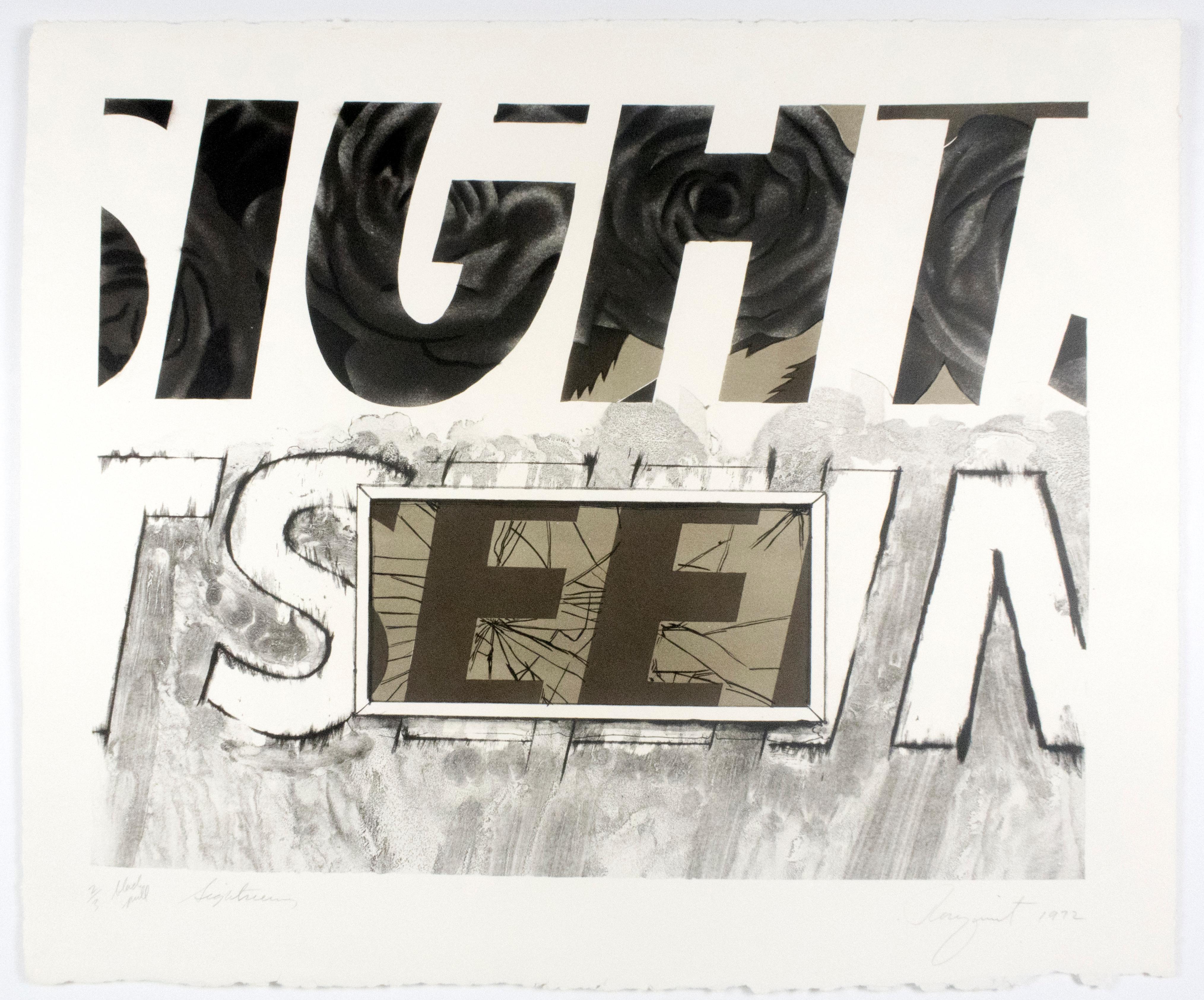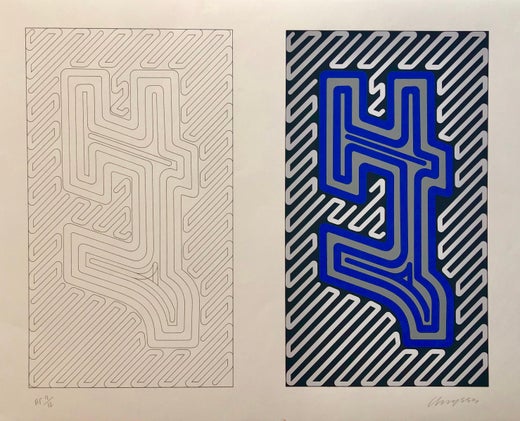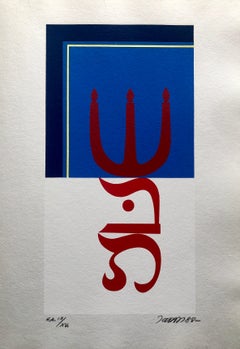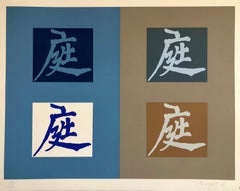
1980's Large Silkscreen Chinese Characters Serigraph Pop Art Print China
View Similar Items
Want more images or videos?
Request additional images or videos from the seller
1 of 8
Chryssa Vardea-Mavromichali1980's Large Silkscreen Chinese Characters Serigraph Pop Art Print China1980
1980
About the Item
- Creator:Chryssa Vardea-Mavromichali (1933 - 2013, Greek)
- Creation Year:1980
- Dimensions:Height: 25 in (63.5 cm)Width: 34 in (86.36 cm)
- Medium:
- Movement & Style:
- Period:
- Condition:minor wear.
- Gallery Location:Surfside, FL
- Reference Number:1stDibs: LU3823297203
Chryssa Vardea-Mavromichali
Chryssa, (born Chryssa Vardea Mavomichali) is best known for her "Luminist" sculpture in brilliantly colored neon tubing, was born in Greece and now ranks as one of the outstanding and innovative artists in America today. Chryssa has had individual and collective exhibition shows at the Museum of Modern Art, The Guggenheim, The Whitney -New York. Harvard University; Institute of Contemporary Art at the University of Pennsylvania; Carnegie Institute among many others.
About the Seller
4.9
Platinum Seller
These expertly vetted sellers are 1stDibs' most experienced sellers and are rated highest by our customers.
Established in 1995
1stDibs seller since 2014
1,549 sales on 1stDibs
Typical response time: 1 hour
More From This SellerView All
- 1980's Large Silkscreen Chinese Characters Serigraph Pop Art Print ChinaBy Chryssa Vardea-MavromichaliLocated in Surfside, FLChryssa Vardea-Mavromichali (Greek: Χρύσα Βαρδέα-Μαυρομιχάλη; December 31, 1933 – December 23, 2013) was a Greek American artist who worked in a wide variety of media. An American art pioneer in light art and luminist sculpture widely known for her neon, steel, aluminum and acrylic glass installations, she has always used the mononym Chryssa professionally. She worked from the mid-1950s in New York City studios and worked since 1992 in the studio she established in Neos Kosmos, Athens, Greece. Chryssa was born in Athens into the famous Mavromichalis family from the Mani Peninsula. one of her sisters, who studied medicine, was a friend of the poet and novelist Nikos Kazantzakis. Chryssa began painting during her teenage years and also studied to be a social worker.In 1953, on the advice of a Greek art critic, her family sent her to Paris to study at the Académie de la Grande Chaumiere where Andre Breton, Edgard Varese, and Max Ernst were among her associates and Alberto Giacometti was a visiting professor. In 1954, at age twenty-one, Chryssa sailed for the United States, arrived in New York and went to San Francisco, California to study at the California School of Fine Arts. Returning to New York in 1955, she became a United States citizen and established a studio in the city. Chryssa's first major work was The Cycladic Books preceded American minimalism by seventeen years. 1961, Chryssa's first solo exhibition was mounted at The Guggenheim. 1963, Chryssa's work was shown at the Museum of Modern Art in curator Dorothy Canning Miller's Americans 1963 exhibition. The artists represented in the show also included Richard Anuszkiewicz, Lee Bontecou, Robert Indiana, Richard Lindner, Marisol, Claes Oldenburg, Ad Reinhardt, James Rosenquist and others. 1966, The Gates to Times Square, regarded as "one of the most important American sculptures of all time" and "a thrilling homage to the living American culture of advertising and mass communications." The work is a 10 ft cube installation of two huge letter 'A's through which visitors may walk into "a gleaming block of stainless steel and Plexiglas that seems to quiver in the play of pale blue neon light" which is controlled by programmed timers. First shown in Manhattan's Pace Gallery, it was given to the Albright-Knox Art Gallery in Buffalo, New York in 1972. 1972, The Whitney Museum of American Art mounted a solo exhibition of works by Chryssa. That's All (early 1970s), the central panel of a triptych related to The Gates of Times Square, was acquired by the Museum of Modern Art between 1975 and 1979. 1973, Chryssa's solo exhibition at the Gallerie Denise René was reviewed for TIME magazine by art critic Robert Hughes before it went on to the Galleries Denise René in Düsseldorf and Paris. Other works by Chryssa in composite honeycomb aluminum and neon in the 1980s and 1990s include Chinatown, Siren, Urban Traffic, and Flapping Birds. Chryssa 60/90 retrospective exhibition in Athens in the Mihalarias Art Center. After her long absence from Greece, a major exhibition including large aluminum sculptures - cityscapes, "neon boxes" from the Gates to the Times Square, paintings, drawings etc. was held in Athens. In 1992, after closing her SoHo studio, which art dealer Leo Castelli had described as "one of the loveliest in the world," Chryssa returned to Greece. She found a derelict cinema which had become a storeroom stacked with abandoned school desks and chairs, behind the old Fix Brewery near the city center in Neos Kosmos, Athens. Using the desks to construct enormous benches, she converted the space into a studio for working on designs and aluminum composite honeycomb sculptures. The Athens National Museum of Contemporary Art, which was founded in 2000 and owns Chryssa's Cycladic Books, is in the process of converting the Fix Brewery into its permanent premises. Greek Exhibits, European Cultural Center of Delphi (Council of Europe). "Apollo's Heritage"(July 4, 2003 – July 30, 2003). Works by sixteen artists: Giorgio de Chirico, Salvador Dalí, Nikos Hadjikyriakos-Ghikas, Nikos Engonopoulos, Yannis Tsarouchis, Giorgos Sikeliotis, Takis, Arman, Fernando Botero, Chryssa, Dimitris Mytaras...Category
1980s Pop Art Abstract Prints
MaterialsScreen
- Surrealist Abstract Hebrew Aleph Pop Art Silkscreen Judaica Jewish SerigraphBy Jozsef JakovitsLocated in Surfside, FLAbstract Hebrew Prints on heavy mould made paper from small edition of 15. there is a facing page of text in Hungarian folded over. Hard edged geometric abstract prints in color base...Category
1980s Pop Art Abstract Prints
MaterialsArchival Paper, Screen
- Surrealist Abstract Hebrew Shabbat Pop Art Silkscreen Judaica Jewish SerigraphBy Jozsef JakovitsLocated in Surfside, FLAbstract Hebrew Prints on heavy mould made paper from small edition of 15. there is a facing page of text in Hungarian folded over. Hard edged geometric abstract prints in color base...Category
1980s Pop Art Abstract Prints
MaterialsArchival Paper, Screen
- 1970's Large Silkscreen Abstract Geometric Day Glo Serigraph Pop Art Print NeonBy Chryssa Vardea-MavromichaliLocated in Surfside, FLSilkscreen on Arches paper, Hand signed and Numbered in Pencil. Serigraph in yellow, red, silver Chryssa Vardea-Mavromichali (Greek: Χρύσα Βαρδέα-Μαυρομιχάλη; December 31, 1933 – December 23, 2013) was a Greek American artist who worked in a wide variety of media. An American art pioneer in light art and luminist sculpture widely known for her neon, steel, aluminum and acrylic glass installations, she has always used the mononym Chryssa professionally. She worked from the mid-1950s in New York City studios and worked since 1992 in the studio she established in Neos Kosmos, Athens, Greece. Chryssa was born in Athens into the famous Mavromichalis family from the Mani Peninsula. one of her sisters, who studied medicine, was a friend of the poet and novelist Nikos Kazantzakis. Chryssa began painting during her teenage years and also studied to be a social worker.In 1953, on the advice of a Greek art critic, her family sent her to Paris to study at the Académie de la Grande Chaumiere where Andre Breton, Edgard Varese, and Max Ernst were among her associates and Alberto Giacometti was a visiting professor. In 1954, at age twenty-one, Chryssa sailed for the United States, arrived in New York and went to San Francisco, California to study at the California School of Fine Arts. Returning to New York in 1955, she became a United States citizen and established a studio in the city. Chryssa's first major work was The Cycladic Books preceded American minimalism by seventeen years. 1961, Chryssa's first solo exhibition was mounted at The Guggenheim. 1963, Chryssa's work was shown at the Museum of Modern Art in curator Dorothy Canning Miller's Americans 1963 exhibition. The artists represented in the show also included Richard Anuszkiewicz, Lee Bontecou, Robert Indiana, Richard Lindner, Marisol, Claes Oldenburg, Ad Reinhardt, James Rosenquist and others. 1966, The Gates to Times Square, regarded as "one of the most important American sculptures of all time" and "a thrilling homage to the living American culture of advertising and mass communications." The work is a 10 ft cube installation of two huge letter 'A's through which visitors may walk into "a gleaming block of stainless steel and Plexiglas that seems to quiver in the play of pale blue neon light" which is controlled by programmed timers. First shown in Manhattan's Pace Gallery, it was given to the Albright-Knox Art Gallery in Buffalo, New York in 1972. 1972, The Whitney Museum of American Art mounted a solo exhibition of works by Chryssa. That's All (early 1970s), the central panel of a triptych related to The Gates of Times Square, was acquired by the Museum of Modern Art between 1975 and 1979. 1973, Chryssa's solo exhibition at the Gallerie Denise René was reviewed for TIME magazine by art critic Robert Hughes before it went on to the Galleries Denise René in Düsseldorf and Paris. Other works by Chryssa in composite honeycomb aluminum and neon in the 1980s and 1990s include Chinatown, Siren, Urban Traffic, and Flapping Birds. Chryssa 60/90 retrospective exhibition in Athens in the Mihalarias Art Center. After her long absence from Greece, a major exhibition including large aluminum sculptures - cityscapes, "neon boxes" from the Gates to the Times Square, paintings, drawings etc. was held in Athens. In 1992, after closing her SoHo studio, which art dealer Leo Castelli had described as "one of the loveliest in the world," Chryssa returned to Greece. She found a derelict cinema which had become a storeroom stacked with abandoned school desks and chairs, behind the old Fix Brewery near the city center in Neos Kosmos, Athens. Using the desks to construct enormous benches, she converted the space into a studio for working on designs and aluminum composite honeycomb sculptures...Category
1980s Pop Art Abstract Prints
MaterialsScreen
- 1970's Large Silkscreen Abstract Geometric Day Glo Serigraph Pop Art Print NeonBy Chryssa Vardea-MavromichaliLocated in Surfside, FLSilkscreen on Arches paper, Hand signed and Numbered in Pencil. Serigraph in blue gray (silver). Chryssa Vardea-Mavromichali (Greek: Χρύσα Βαρδέα-Μαυρομιχάλη; December 31, 1933 – December 23, 2013) was a Greek American artist who worked in a wide variety of media. An American art pioneer in light art and luminist sculpture widely known for her neon, steel, aluminum and acrylic glass installations, she has always used the mononym Chryssa professionally. She worked from the mid-1950s in New York City studios and worked since 1992 in the studio she established in Neos Kosmos, Athens, Greece. Chryssa was born in Athens into the famous Mavromichalis family from the Mani Peninsula. one of her sisters, who studied medicine, was a friend of the poet and novelist Nikos Kazantzakis. Chryssa began painting during her teenage years and also studied to be a social worker.In 1953, on the advice of a Greek art critic, her family sent her to Paris to study at the Académie de la Grande Chaumiere where Andre Breton, Edgard Varese, and Max Ernst were among her associates and Alberto Giacometti was a visiting professor. In 1954, at age twenty-one, Chryssa sailed for the United States, arrived in New York and went to San Francisco, California to study at the California School of Fine Arts. Returning to New York in 1955, she became a United States citizen and established a studio in the city. Chryssa's first major work was The Cycladic Books preceded American minimalism by seventeen years. 1961, Chryssa's first solo exhibition was mounted at The Guggenheim. 1963, Chryssa's work was shown at the Museum of Modern Art in curator Dorothy Canning Miller's Americans 1963 exhibition. The artists represented in the show also included Richard Anuszkiewicz, Lee Bontecou, Robert Indiana, Richard Lindner, Marisol, Claes Oldenburg, Ad Reinhardt, James Rosenquist and others. 1966, The Gates to Times Square, regarded as "one of the most important American sculptures of all time" and "a thrilling homage to the living American culture of advertising and mass communications." The work is a 10 ft cube installation of two huge letter 'A's through which visitors may walk into "a gleaming block of stainless steel and Plexiglas that seems to quiver in the play of pale blue neon light" which is controlled by programmed timers. First shown in Manhattan's Pace Gallery, it was given to the Albright-Knox Art Gallery in Buffalo, New York in 1972. 1972, The Whitney Museum of American Art mounted a solo exhibition of works by Chryssa. That's All (early 1970s), the central panel of a triptych related to The Gates of Times Square, was acquired by the Museum of Modern Art between 1975 and 1979. 1973, Chryssa's solo exhibition at the Gallerie Denise René was reviewed for TIME magazine by art critic Robert Hughes before it went on to the Galleries Denise René in Düsseldorf and Paris. Other works by Chryssa in composite honeycomb aluminum and neon in the 1980s and 1990s include Chinatown, Siren, Urban Traffic, and Flapping Birds. Chryssa 60/90 retrospective exhibition in Athens in the Mihalarias Art Center. After her long absence from Greece, a major exhibition including large aluminum sculptures - cityscapes, "neon boxes" from the Gates to the Times Square, paintings, drawings etc. was held in Athens. In 1992, after closing her SoHo studio, which art dealer Leo Castelli had described as "one of the loveliest in the world," Chryssa returned to Greece. She found a derelict cinema which had become a storeroom stacked with abandoned school desks and chairs, behind the old Fix Brewery near the city center in Neos Kosmos, Athens. Using the desks to construct enormous benches, she converted the space into a studio for working on designs and aluminum composite honeycomb sculptures...Category
1980s Pop Art Abstract Prints
MaterialsScreen
- 1970's Large Silkscreen Abstract Geometric Day Glo Serigraph Pop Art Print NeonBy Chryssa Vardea-MavromichaliLocated in Surfside, FLSilkscreen on Arches paper, Hand signed and Numbered in Pencil. Serigraph in white, back, blue gray (silver). Chryssa Vardea-Mavromichali (Greek: Χρύσα Βαρδέα-Μαυρομιχάλη; December 31, 1933 – December 23, 2013) was a Greek American artist who worked in a wide variety of media. An American art pioneer in light art and luminist sculpture widely known for her neon, steel, aluminum and acrylic glass installations, she has always used the mononym Chryssa professionally. She worked from the mid-1950s in New York City studios and worked since 1992 in the studio she established in Neos Kosmos, Athens, Greece. Chryssa was born in Athens into the famous Mavromichalis family from the Mani Peninsula. one of her sisters, who studied medicine, was a friend of the poet and novelist Nikos Kazantzakis. Chryssa began painting during her teenage years and also studied to be a social worker.In 1953, on the advice of a Greek art critic, her family sent her to Paris to study at the Académie de la Grande Chaumiere where Andre Breton, Edgard Varese, and Max Ernst were among her associates and Alberto Giacometti was a visiting professor. In 1954, at age twenty-one, Chryssa sailed for the United States, arrived in New York and went to San Francisco, California to study at the California School of Fine Arts. Returning to New York in 1955, she became a United States citizen and established a studio in the city. Chryssa's first major work was The Cycladic Books preceded American minimalism by seventeen years. 1961, Chryssa's first solo exhibition was mounted at The Guggenheim. 1963, Chryssa's work was shown at the Museum of Modern Art in curator Dorothy Canning Miller's Americans 1963 exhibition. The artists represented in the show also included Richard Anuszkiewicz, Lee Bontecou, Robert Indiana, Richard Lindner, Marisol, Claes Oldenburg, Ad Reinhardt, James Rosenquist and others. 1966, The Gates to Times Square, regarded as "one of the most important American sculptures of all time" and "a thrilling homage to the living American culture of advertising and mass communications." The work is a 10 ft cube installation of two huge letter 'A's through which visitors may walk into "a gleaming block of stainless steel and Plexiglas that seems to quiver in the play of pale blue neon light" which is controlled by programmed timers. First shown in Manhattan's Pace Gallery, it was given to the Albright-Knox Art Gallery in Buffalo, New York in 1972. 1972, The Whitney Museum of American Art mounted a solo exhibition of works by Chryssa. That's All (early 1970s), the central panel of a triptych related to The Gates of Times Square, was acquired by the Museum of Modern Art between 1975 and 1979. 1973, Chryssa's solo exhibition at the Gallerie Denise René was reviewed for TIME magazine by art critic Robert Hughes before it went on to the Galleries Denise René in Düsseldorf and Paris. Other works by Chryssa in composite honeycomb aluminum and neon in the 1980s and 1990s include Chinatown, Siren, Urban Traffic, and Flapping Birds. Chryssa 60/90 retrospective exhibition in Athens in the Mihalarias Art Center. After her long absence from Greece, a major exhibition including large aluminum sculptures - cityscapes, "neon boxes" from the Gates to the Times Square, paintings, drawings etc. was held in Athens. In 1992, after closing her SoHo studio, which art dealer Leo Castelli had described as "one of the loveliest in the world," Chryssa returned to Greece. She found a derelict cinema which had become a storeroom stacked with abandoned school desks and chairs, behind the old Fix Brewery near the city center in Neos Kosmos, Athens. Using the desks to construct enormous benches, she converted the space into a studio for working on designs and aluminum composite honeycomb sculptures...Category
1980s Pop Art Abstract Prints
MaterialsScreen
You May Also Like
- "Moi je veux vivre monotone" by Patrick Caulfield, Screenprint, Pop Art, PurpleBy Patrick CaulfieldLocated in Köln, DE"Moi je veux vivre monotone" is from the series "Some poems by Jules Laforgue". Patrick Caulfied was deeply inspired by these poems and found to his very own depiction of these poems...Category
1970s Pop Art Abstract Prints
MaterialsScreen
- BrushstrokeBy Roy LichtensteinLocated in Miami, FLHand signed rf Lichtenstein in pencil and numbered lower right margin. Published by Leo Castelli Gallery, New York, Printer Chiron Press, New York. The Prints ofRoy Lichtenstein A Ca...Category
1960s Pop Art Abstract Prints
MaterialsScreen
Price Upon Request - Bicentennial, by Roy LichtensteinBy Roy LichtensteinLocated in New York, NYIncluded in America: The Third Century portfolio, Roy Lichtenstein created Bicentennial as an original color lithograph with screenprint in 1975, conceived to celebrate the 200th ann...Category
20th Century Pop Art More Prints
MaterialsLithograph, Screen
Price Upon Request - Sajippe Kraka JoujeshBy Kenny ScharfLocated in Miami, FLTECHNICAL INFORMATION: Kenny Scharf Sajippe Kraka Joujesh 1998 Screenprint 40 x 46 in. Edition of 150 Pencil signed and numbered Condition: This work is in excellent conditionCategory
1990s Pop Art Abstract Prints
MaterialsScreen
Price Upon Request - Quelques Poèmes de Jules LaforgueBy Patrick CaulfieldLocated in New York, NYBound portfolio with complete text, 22 color screenprints on Neobond papier synthétique. One of 200 copies (French edition) from a total edition of 500. Signed, numbered 101/200 and inscribed "Edition B" on the justification page. Printed by Christopher Betambeau, London. Published by Petersburg Press, London. Original gray leather folders...Category
1970s Pop Art Abstract Prints
MaterialsSynthetic Paper, Color, Screen
- ART (Sheehan, 80) iconic 1970s geometric abstraction lt ed s/n for Colby CollegeBy Robert IndianaLocated in New York, NYRobert Indiana Colby ART (Sheehan, 80), 1973 Silkscreen in Colors on White Wove Paper Pencil signed and numbered 69/100 on the front with artist's copyright @Robert Indiana lower right front Published by Robert Indiana with copyright; Printed by Seri-Arts, Inc. Vintage metal frame included Classic early 1970s work. There was a time, we are told, when every prestigious collector in Germany would have an edition of Robert Indiana's iconic ART print prominently hanging in their home. This is an uncommon and desirable Robert Indiana piece from the early 1970s. Boldly signed in graphite on the recto (front), numbered and bearing the artist's copyright: @ Robert Indiana 1973...Category
1970s Pop Art Abstract Prints
MaterialsScreen, Pencil
Recently Viewed
View AllMore Ways To Browse
Chinese Character
Chinese Famous
1980 Stainless
July 4
Chinese Art On Panels
Heritage China
Retro 1950s Space Art
China Ad
Triptych Art Prints
Print Triptych
The Paris Review Print
American Block Prints
All Dali Prints
Medicine Print
Vintage Lee Prints
Paris Review Print
Chinese Blue Print
Bird Prints American Large

